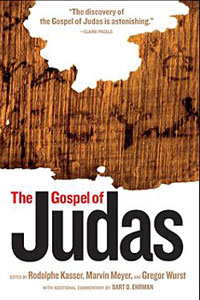Book Notes
 Rodolphe Kasser, Marvin Meyer, and Gregor Wurst, editors, with additional commentary by Bart D. Ehrman, The Gospel of Judas (Washington, DC: National Geographic Society, 2006), 185pp.
Rodolphe Kasser, Marvin Meyer, and Gregor Wurst, editors, with additional commentary by Bart D. Ehrman, The Gospel of Judas (Washington, DC: National Geographic Society, 2006), 185pp.
In the year 2000 the Swiss antiquities dealer Frieda Tchacos Nussberger acquired a sixty-six page papyrus codex (now called Codex Tchacos) that contained four books or treatises, one of which turned out to be the long known but long lost Gospel of Judas. The codex was in horrible condition, "a thousand fragments scattered like crumbs." When Rodolphe Kasser of Geneva, a renowned Coptologist, saw it for the first time on the evening of July 24, 2001, he described it as "partially pulverized, infinitely fragile, crumbling at the least contact." Nussberger gave the manuscript to the Maecenas Foundation for Ancient Art, which through collaborative efforts restored as much as 80 percent of the codex, which will eventually be given to the Coptic Museum in Cairo. This brief description, however, hardly does justice to the murky origins and history of Codex Tchacos before it came to Nussberger. A companion volume by the National Geographic Society entitled The Lost Gospel (2006) tries to reconstruct that mysterious past.
The original Gospel of Judas (which we do not have) was composed in Greek some time before 180, when Irenaeus mentions it in his work Against Heresies. The version we have in the Codex Tchacos is a later Coptic translation from the Greek that according to radiocarbon-dating was composed between 220–340, with a margin of error of +/- sixty years. The present volume is its first translation into English.
The Gospel of Judas is only one of several dozen apocryphal writings of the early Christian era, some of them now extant only as fragmented papyri, others known only in name (like Paul's letter to the Laodiceans per Colossians 4:16), that did not find their way into the canon or "rule" of Scripture that bear authentic witness to Christ. Scholars agree that the Judas gospel is a "gnostic" text (from the Greek word gnosis, knowledge), although this is such an elastic term for a broad variety of movements that "some scholars have insisted that we shouldn't even use the term any more" (Ehrman). The gospel, according to the very first sentence, contains "the secret account of the revelation that Jesus spoke in conversation with Judas Iscariot during a week three days before he celebrated Passover." Parts of it like its cosmology are so complex that they are almost impossible to understand. Other passages portray Judas as a hero who betrays Jesus at his own request, and not as the quintessential villain. Overall, the gospel "contains very little that could be considered specifically Christian" (Meyer; so too Ehrman, p. 102).
The Gospel of Judas itself is barely ten pages long, and significant parts of it are badly corrupted with long lacunae. Here is one example: "So let them be {ensnared}before you, and let them go {—about 15 lines missing—} generations {. . .}. A baker cannot feed all creation {42}under {heaven}. And {. . .}to them {. . .}and {. . .}to us and {. . .}." The 151 footnotes to the short text are full of interpretive choices, and significant caveats like "the meaning of the text is uncertain" or "the translation is tentative." The editors have inserted subtitles in the text to smooth the narrative flow. The brief Gospel is preceded by an introduction by Meyer, then followed by four commentaries by Kasser, Ehrman, Wurst, and Meyer. A brief bibliography (the literature on Judas is immense) concludes this archaeological treasure that will keep scholars of many disciplines hard at work for decades to come. In the mean time, the National Geographic Society has an informative website on the text at http://www9.nationalgeographic.com/lostgospel/.


